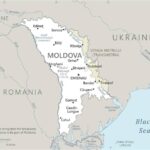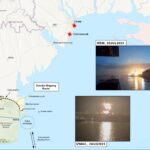Gazprom’s pipelaying vessel “Akademik Cherskiy” is entering the Baltic Sea. The Russian-flagged vessel was likely dispatched to complete the remaining 6% of the controversial North Stream 2 gas pipeline. The Akademik Cherskiy’s arrival in the Baltic Sea marks the end of a trip around the world that started in February 2020, when the vessel left its homeport Nakhodka on Russia’s Pacific coast. It is possible that the pipelayer will first conduct a port-call for maintenance and repairs in Kaliningrad or Sankt-Petersburg, before commencing work on the last segment of North Stream 2 near the Danish island of Bornholm.
NORTH STREAM 2: A THREAT TO EUROPEAN ENERGY SECURITY
North Stream 2 is a submarine pipeline that will carry natural gas from Russian fields to a terminal on Germany’s Baltic sea coast. The pipeline will more than double the existing capacity of the original North Stream, which was completed in 2011. Besides the Russian energy giant Gazprom, five European companies (OMV, Royal Dutch Shell, Uniper SE, Engie SA and Wintershall AG) participate in the North Stream 2 project.
North Stream 2 route (source: ICIS.com)
North Stream 2 will significantly increase the EU’s dependency on Russian gas, which the Kremlin has never shied away from using as leverage. Considering the potential geopolitical impact of the pipeline, the Western European support of North Stream 2 has left the Eastern European countries feeling aghast and betrayed. While the EU has been advocating for the diversification of energy sources and suppliers for years, the Union’s core members now seem willing to continue embracing Russian gas.
Ukraine’s national security, in particular, will be impacted by North Stream 2. Before Russia’ annexation of Crimea and covert invasion of Eastern Ukraine, Gazprom was sending 60 percent of its gas exports to Europe through pipelines in Ukraine. While deliveries will continue until 2024, Ukraine’s status as a transit state for Russian gas will be weakened by the new pipeline. As a result, Kyiv will lose whatever geopolitical leverage it has against its hostile neighbor.
US SANCTIONS FROZE PIPELINE AT 94%
Roughly 94 percent of the 1,230 kilometers (764 miles) long North Stream 2 pipeline was completed when the Trump administration put the companies of the consortium under sanctions. The Swiss company Allseas Group SA stopped the process of laying underwater pipes in late December 2019, leaving a small gap in the pipeline located in Danish waters around the island of Bornholm (between Sweden and Germany’s Baltic coast). Since then, the Kremlin has been scrambling for options to continue construction. The delay will push the opening to mid-2020 at the earliest. In 2019, the Russian Foreign Minister named the pipelaying vessel Akademik Cherskiy, which has now arrived in the Baltic Sea, as one of the available options to complete the pipeline.
EURO-ATLANTIC SPLIT
If work on North Stream 2 resumes, the split between the United States and the EU countries that participate in the energy project will likely deepen. The Central and Eastern member states of the EU will continue to side with the U.S. and promote the Three Seas Initiative (3SI). The 3SI’s main project is to facilitate the influx of American liquefied natural gas (LNG) to the Eastern European energy market as an affordable alternative to crude Russian gas. To this end, Poland has invested generously in its Swinoujscie LNG terminal on the Baltic Sea coast, where vessels from the United States can unload cargo.
- Russia Bombs Maternity Ward & Children’s Hospital in Mariupol As Part of Siege - 10 March 2022
- T-Intell’s OSINT Training Marks One Year Anniversary - 18 November 2021
- IS-K Never Left the Battlefield - 27 August 2021









